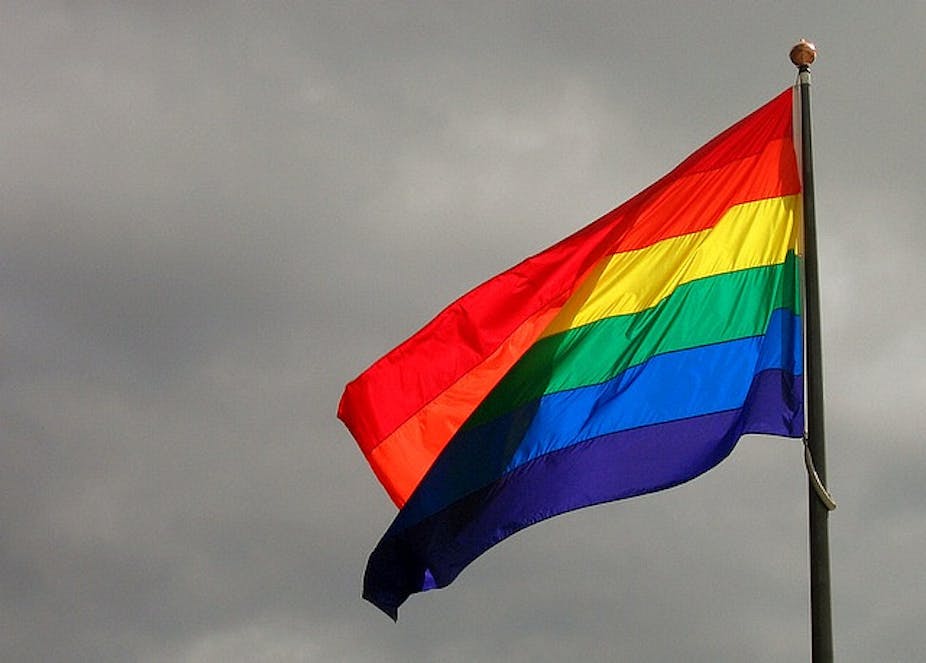Homophilia, a term once used to define “unnatural” relations between same-sex people in the early- to mid-20th century has been given a makeover. Urban gay communities around the world are using homophilia to mean an open, supportive and non-judgemental acceptance towards gays and lesbians.
Like the word queer before it, homophilia is a rebuttal to homophobia.
By definition, homophiles are able to form bonds and associations with others based on their similarities, rather than their differences. And plenty of common ground can be found between people who identify as homosexual and those who don’t.
The first step to embracing commonalities is to do away with prejudicial definitions of difference – an area in which medicine has played a crucial part.
Historical definitions
In the late 19th century, medico-legal experts defined homosexuality as a mental illness in order to exonerate the accused with a plea of insanity. While this reasoning freed some homosexual people, it led to the institutionalisation and abuse of many.
German physician Karl Westphal proposed that same-sex attraction was congenital and those who were “afflicted” should come under psychiatric care, rather than legal prosecution. Similarly, other health practitioners believed that homosexuality was a severe manifestation of “hereditary degeneration”, akin to severe epilepsy and schizophrenia.

Jump to the 1980s and the naming of AIDS. In the early days of the disease, it was referred to as the “gay bowel syndrome”, which suggests the disease is gay-specific and that homosexuality contributes to the contraction of the disease. It’s difficult to find a similarly named counterpart disease in the heterosexual community.
Historically, the medical profession played a key role in defining homosexuality as a form of illness. But by embracing homophilia, modern professionals have an opportunity to undo some of the hardships created by pathologizing same-sex attraction.
What’s in a name?
Homosexuality has existed for centuries. But how it’s defined and labelled – as a sin, an act against morality, a physical illness, a psychiatric condition, and more recently, a lifestyle – has changed considerably over time. These socially imputed definitions of homosexually have had a significant impact on individuals.
Let’s look at this influence through the eyes of a young boy born at the beginning of the 20th century who has “special” romantic and sexual feelings for other boys. When his parents become aware of their son’s feelings at the age of 18, he is rushed to a physician, who, as the expert of the day on such matters, explains that the boy has a biological condition requiring a medical intervention.
Lucky for this boy, a lobotomy is not performed. But he may have been subjected to cold sitz baths (soaking the pelvis and genitals in cold water mixed with essential oils to draw out “infection”), sterilization, castration or the sectioning of his pudic nerve.
Despite the prescribed treatment, his feelings and attraction towards boys remain. Fifty years later, he seeks the treatment offered by psychiatrists, who now view the problem as a “mental illness” and subject him to unsuccessful aversion therapy.
Now in his late 80s, he is watching the Sydney Mardi Gras parade on national television. He is shocked by the goodwill messages from parents and politicians, and the platoon of openly gay doctors, psychiatrists and police officers who lobby for equal rights.

As he reflects on his life, including several attempts of suicide, he cannot help but conclude that time has made an enormous difference in how homosexuality has been defined. Unfortunately for him, he was socialised into accepting that homosexuality was a problem, and he internalised homophobic attitudes, which had a profound influence on how he lived his life.
Homophobia and health outcomes
While people who identify as homosexual, or anything other than “straight”, may no longer be asked to soak their bottoms in oil-infused ice water, they continue to endure a high level of societal intolerance. And this can have significant emotional and psychological impacts.

Consider these alarming statistics:
- One-third of Australian adults believe homosexuality is immoral.
- Between 17% and 30% of gay men experience depression as a result of homophobic bullying, violence, isolation and lack of societal acceptance.
- Homosexual people are more likely to abuse alcohol and drugs than their heterosexual friends.
- Between 30% and 40% of homosexual youth have attempted a suicide, which is up to four times higher than their heterosexual peers.
With statistics such as these, it’s clear health professionals need to do their part and leave homophobic classifications and definitions behind.
A recent study found that because of practitioner inexperience, lack of skills, or negative attitudes, more than half of Australian GPs (54% to 60%) were uncomfortable caring for gay and lesbian clients. Becoming open, supportive and non-judgemental is imperative to addressing the health needs of non-heterosexual clients. And this requires better education.
Improving health professional competency in dealing with sexually diverse populations also speaks to the role that providers can play in fufilling the Australian Government’s National Suicide Prevention Strategy, aimed at suicide prevention through mental and physical health promotion.
By embracing an attitude of homophilia, the social and health systems which once capitalised on difference can be dissolved. It can, does and will get better.
If you or someone you know who needs help contact Lifeline’s 24-hour helpline on 13 11 14, SANE Australia on 1800 18 7263 or the Beyondblue Info Line 1300 22 4636.

